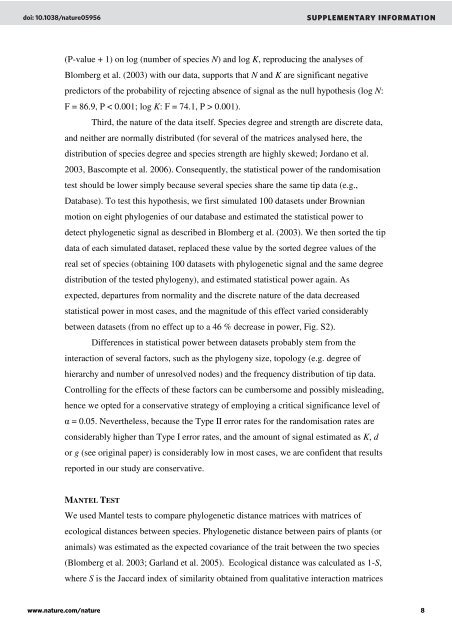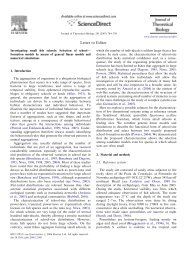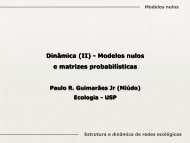SUPPLEMENTARY INFORMATION - Paulo R. Guimarães Jr.
SUPPLEMENTARY INFORMATION - Paulo R. Guimarães Jr.
SUPPLEMENTARY INFORMATION - Paulo R. Guimarães Jr.
You also want an ePaper? Increase the reach of your titles
YUMPU automatically turns print PDFs into web optimized ePapers that Google loves.
5956 <br />
(P-value + 1) on log (number of species N) and log K, reproducing the analyses of<br />
Blomberg et al. (2003) with our data, supports that N and K are significant negative<br />
predictors of the probability of rejecting absence of signal as the null hypothesis (log N:<br />
F = 86.9, P < 0.001; log K: F = 74.1, P > 0.001).<br />
Third, the nature of the data itself. Species degree and strength are discrete data,<br />
and neither are normally distributed (for several of the matrices analysed here, the<br />
distribution of species degree and species strength are highly skewed; Jordano et al.<br />
2003, Bascompte et al. 2006). Consequently, the statistical power of the randomisation<br />
test should be lower simply because several species share the same tip data (e.g.,<br />
Database). To test this hypothesis, we first simulated 100 datasets under Brownian<br />
motion on eight phylogenies of our database and estimated the statistical power to<br />
detect phylogenetic signal as described in Blomberg et al. (2003). We then sorted the tip<br />
data of each simulated dataset, replaced these value by the sorted degree values of the<br />
real set of species (obtaining 100 datasets with phylogenetic signal and the same degree<br />
distribution of the tested phylogeny), and estimated statistical power again. As<br />
expected, departures from normality and the discrete nature of the data decreased<br />
statistical power in most cases, and the magnitude of this effect varied considerably<br />
between datasets (from no effect up to a 46 % decrease in power, Fig. S2).<br />
Differences in statistical power between datasets probably stem from the<br />
interaction of several factors, such as the phylogeny size, topology (e.g. degree of<br />
hierarchy and number of unresolved nodes) and the frequency distribution of tip data.<br />
Controlling for the effects of these factors can be cumbersome and possibly misleading,<br />
hence we opted for a conservative strategy of employing a critical significance level of<br />
! = 0.05. Nevertheless, because the Type II error rates for the randomisation rates are<br />
considerably higher than Type I error rates, and the amount of signal estimated as K, d<br />
or g (see original paper) is considerably low in most cases, we are confident that results<br />
reported in our study are conservative.<br />
MANTEL TEST<br />
We used Mantel tests to compare phylogenetic distance matrices with matrices of<br />
ecological distances between species. Phylogenetic distance between pairs of plants (or<br />
animals) was estimated as the expected covariance of the trait between the two species<br />
(Blomberg et al. 2003; Garland et al. 2005). Ecological distance was calculated as 1-S,<br />
where S is the Jaccard index of similarity obtained from qualitative interaction matrices





